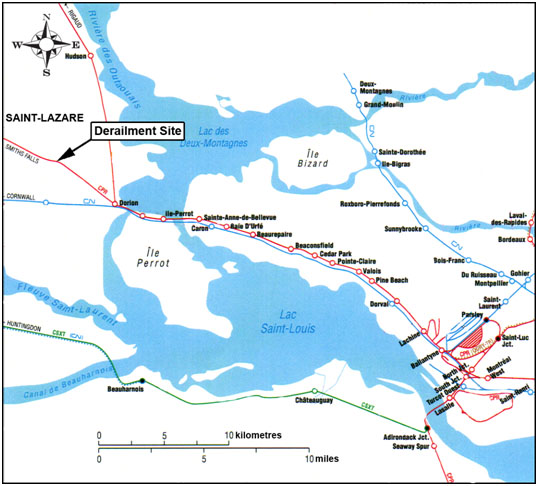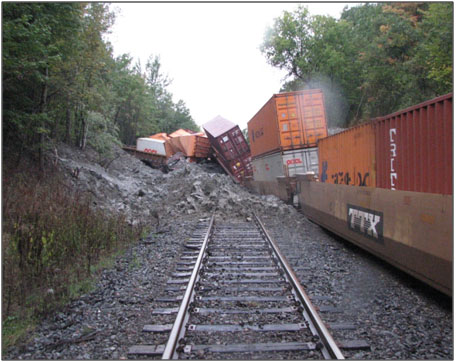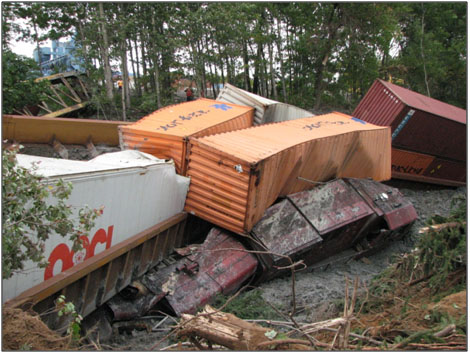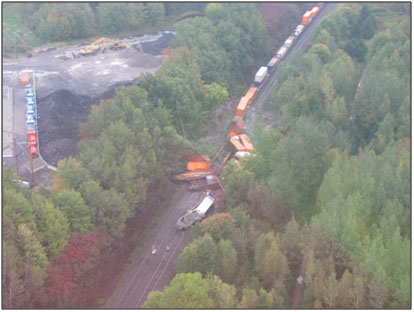Main-track derailment
Canadian Pacific Railway
Freight train 159-23
Mile 22.2, Winchester Subdivision
Saint-Lazare, Quebec
The Transportation Safety Board of Canada (TSB) investigated this occurrence for the purpose of advancing transportation safety. It is not the function of the Board to assign fault or determine civil or criminal liability. This report is not created for use in the context of legal, disciplinary or other proceedings. See Ownership and use of content. Masculine pronouns and position titles may be used to signify all genders to comply with the Canadian Transportation Accident Investigation and Safety Board Act (S.C. 1989, c. 3).
Summary
On 23 September 2010, at approximately 2335 Eastern Daylight Time, Canadian Pacific Railway freight train 159-23 derailed 2 locomotives and 11 loaded cars at Mile 22.2 of the Winchester Subdivision near Saint-Lazare, Quebec. Approximately 500 feet of track was damaged. The accident caused two minor injuries and a small spill of dangerous goods.
Ce rapport est également disponible en français.
Factual information
The accident
On 23 September 2010, Canadian Pacific Railway (CP) freight train 159-23 (the train), en route from Montreal, Quebec, was proceeding westward through the Winchester Subdivision toward Detroit, Michigan (see Figure 1). The train consisted of 2 locomotives and 54 loaded container cars (42 single cars and 12 multi-platform cars), 9 of which contained dangerous goods. It weighed about 5,300 tons and was approximately 6,000 feet long.
The crew consisted of a locomotive engineer and a conductor. They were familiar with the area, were qualified for their respective positions, and met fitness and rest standards.
Around 2330,Footnote 1 the train left Dorion, Quebec using the north main track. While the train was travelling at 50 mph, it passed the 221 signal (Mile 22.1), which was showing a clear indication, and the crew noticed that the track ahead was obstructed by debris. The engineer reduced the throttle and initiated an emergency brake application. The train was unable to stop before hitting the debris and derailing (see Photo 1).
The crew were trapped in the lead locomotive cab. The engineer sent an emergency message to the rail traffic controller (RTC), who alerted local emergency services. The fire department arrived on site approximately 20 minutes later and assisted the crew.
The temperature was 11°C and there were rain showers.
The 10th and 11th cars were carrying placarded containers. The products were flammable liquids, oxidants and toxic and corrosive substances. According to CP and Environment Canada, two 1,000-kg bags of iron dichloride (UN 1773) were torn open, and approximately 5 litres of motor oil were spilled. A safety perimeter was established around the derailment zone; it was lifted after all dangerous goods had been removed.
Site examination
In the derailment zone, which covered a distance of approximately 500 feet, the track ran through a forest that extended mainly to the south. The track occupied a through-cut that had been excavated to a depth of up to 14 feet below the natural terrain. It had a 0° 32" curve to the left, in the direction that the train was travelling. One area of the terrain, approximately 200 feet wide in the wooded section north of the track, had slid onto the track, covering it with a layer of clay and plant material approximately 6 feet deep.
The derailed rolling stock included 2 locomotives and 11 loaded container cars (9 single cars and 2 multi-platform cars). The locomotives had crossed the south track and stopped against the south slope of the through-cut, approximately 1,500 feet west of the 221 signal. The front part of the lead locomotive was covered in debris, blocking the exits. The second locomotive uncoupled from the lead locomotive and was tilted over into the ditch beside the track.
The double-stack container cars (1st to 9th car) had lost their trucks, derailed and piled up on the track, with some cars on top of the locomotives (see Photo 2). The 10th and 11th cars, which were multi-platform container cars, derailed. The 10th car climbed up and derailed on the south side, and the 11th car stayed upright on the roadbed.
The derailed rolling stock was examined; no pre-derailment defects were found. No wheel marks or dragging equipment marks were observed to the east of the point of derailment. The train had passed a wayside inspection system at Mile 12.5 in the Vaudreuil Subdivision without triggering any alarms.
The derailment zone is bordered on the north side by an asphalt plant (lot 1 673 921 on Rue du Plateau, in the municipality of Vaudreuil-Dorion) that produces asphalt mix (see Photo 3). In the wooded area between the plant grounds and the track, the trees were tilted northward, and there were cracks in the ground several feet deep and wide. At the edge of the wooded area, concrete Jersey barriers enclosed a storage area for scrap asphalt mix. The storage scrap pile was approximately 15 feet high. The soil had failed under the storage scrap pile, causing the formation of shear cracks and the collapse of the storage scrap pile.
Particulars of the track
The track consisted of 115-pound continuous welded rail (CWR) laid on double-shouldered tie plates secured with four spikes per tie. There were about 3,200 hardwood ties per mile of track. There were rail anchors every second tie. The ballast consisted mainly of crushed rock, was in good condition and showed no signs of fouling. The cribs were full and the shoulders were about 18 inches wide.
Track information
The Winchester Subdivision consists of double track. It was built in the 1880s and connects Dorion, at Mile 18.9, to Smiths Falls, Ontario, at Mile 123.8. Train movements are governed by the occupancy control system and automatic block signal system rules (OCS/ABS), as authorized under the Canadian Rail Operating Rules, and under the supervision of an RTC located in Montreal. The track is Class 4 as defined in the Railway Track Safety Rules (TSR), as approved by Transport Canada. In the accident zone, the maximum authorized speed is 60 mph for freight trains. Rail traffic consists of 16 freight trains per day, with an annual tonnage of approximately 29 million gross tons.
Track inspections
The track in the vicinity of the accident had been inspected in accordance with the TSR. Two inspections were conducted with a track geometry test vehicle. The most recent inspection, on 01 September 2010, found no defects. Four continuous inspections for internal rail defects had been conducted. No defects were found during the last inspection conducted on 29 July 2010. There were 69 regular track inspections performed by hi-rail vehicle in the six months preceding the accident. The most recent track inspection was conducted on the day of the derailment, and no defects were identified. In addition, at approximately 2130, freight train 123-23 passed on the north track, and the crew did not observe any unusual conditions.
TSR Track Inspectors conduct inspection of cuts and embankments as per the Redbook of Track Requirements, Section 14.5.0 ''Track Inspection - Items, Methods, Actions. If a natural hazard is detected during an inspection, an incident report must be completed and submitted to the geotechnical staff at Engineering within 24 hours for further investigation. This process does not replace existing RTC emergency notification protocols.
Sensitive clays of the Champlain Sea
The major urban areas in Quebec and Ontario are grouped along the major transportation corridor that is the St. Lawrence Valley. The corridor, which was flooded by the Champlain Sea over 10,000 years ago, contains substantial layers of marine clay extending over vast areas. They can be very sensitiveFootnote 2 and compressible, and depending on their spatial distribution, they can lead to landslides.Footnote 3
After the sea retreated, the salts that originally contributed to the bonding of the particles were slowly removed (leached) by fresh water filtering through the ground. If sufficiently disturbed, the leached marine clay, a weak but water-rich sediment, may liquefyFootnote 4. Triggering factors include river erosion, increases in pore-water pressure (especially during periods of high rainfall or rapid snowmelt), earthquakes, and human activities such as excavation and construction.
Geotechnical assessment by Canadian Pacific Railway
TSR hired a specialized company to conduct a geotechnical investigation of the accident site in order to determine the stability of the ground adjacent to the track. The study determined that the soil is made up of a 10-foot sandy layer over layers of clay that are brown at the surface and become grey with depth. The clay is sensitive but its strength increases with depth.
The stability analysis indicated that in the absence of a storage scrap pile, the slope adjacent to the railway would have been stable (safety factor 1.53Footnote 5). With the build-up of a 15-foot storage scrap pile, the safety factor dropped to 0.93, and the slope became susceptible to sliding.
Université Laval study
Parallel to the study conducted by TSR, the TSB requested the Université Laval Faculty of Science and Engineering to conduct an analysis of the stability of the slope using SLOPE_W software, based on various factors such as the height of the storage scrap pile and the soil resistance parameters. SLOPE_W enables users to calculate the safety factor of a slope for various slip surface shapes, pore pressure conditions, soil properties and loading conditions.
According to the SLOPE_W analyses, the terrain would be stable in the absence of the storage scrap pile. The safety factor decreases when the height of the storage scrap pile increases. The slope may rupture, with a rupture surface at a depth of approximately 50 feet, once the height of the storage scrap pile reaches 9 feet.
Certificate of authorization
Under the Environment Quality Act (EQA), a certificate of authorization issued by the Ministry of Sustainable Development, Environment and Parks (MDDEP) is required for certain activities or projects that may impact the environment.
Section 22 of the EQA states:
No one may erect or alter a structure, undertake to operate an industry, carry on an activity or use an industrial process or increase the production of any goods or services if it seems likely that this will result in an emission, deposit, issuance or discharge of contaminants into the environment or a change in the quality of the environment, unless he first obtains from the Minister a certificate of authorization.
All applications for certificates of authorization must include certain information and documents providing details about the applicant, the project location, the nature of the project and the possible environmental impacts of the project.
The Vaudreuil-Dorion plant produces asphalt mix using bulk materials (crushed aggregate, sand and asphalt) or recycled materials recovered from road surfacing projects and plant waste. These recycled materials had been stored since summer 2009. The storage scrap pile was heightened, as materials were dropped off at the foot of the pile and transported to the top by a loader. An application for a certificate of authorization was submitted to the MDDEP in February 2008 for operation of the plant, and the certificate was issued on 7 August 2008.
Zoning plan and municipal approval
The Land Use Planning and Development Act requires that regional county municipalities (RCM) identify zones where land occupation is subject to major restrictions due to potential hazards to public safety, health and well-being. Protective measures must be set out in the municipal regulations to restrict construction within those zones.
Since 2003, the ministère des Transports du Québec (MTQ) has been producing maps of areas that are susceptible to landslides. These maps are provided to RCMs to be integrated into municipal zoning plans and land use plans. Municipalities must clearly identify zones where land occupation is subject to special restrictions for reasons of public safety.
No map was created for the Vaudreuil-Soulanges RCM area. However, the nature of the unconsolidated deposits in the area, consisting of till, loam and sensitive marine clay, makes the area susceptible to landslides in sections that have steep slopes, poor drainage and sparse vegetation. For that reason, the RCM identified the areas susceptible to landslides through an analysis of aerial photos and ground surveys. These areas were shown in linear strips corresponding to relatively steep clay riverbanks, or slopes of old marine terraces. These at-risk areas, which did not include the asphalt mix plant site, were superimposed on flood-risk areas and integrated into the municipality zoning plan.
The plant project was approved by municipal authorities in December 2008, and “new industrial construction” and “septic system” permits were issued. For these permits to be granted, the MDDEP certificate of authorization is required, and the zoning plan as well as any clauses in the municipal regulations must be respected. The regulations require that outdoor storage be completely fenced in so that it is not visible from the road. There are no requirements for a geotechnical analysis of the load-bearing capacity of the ground. The applicant is not required to conduct an impact analysis on neighbouring properties, nor is it obligated to consult with neighbouring owners on planned activities.
Land use affecting railway safety and consultation
Under the Notice of Railway Works Regulations, a railway company must give notice of prescribed railway works to several parties including adjacent landowners and the municipality. Conversely, subsection 24 (1) of part III of the Railway Safety Act (RSA) enables Transport Canada to regulate non-railway activities on land adjoining the land on which a line of railway is situated, that could constitute a threat to safe railway operations. In the Mining Near Lines of Railways Regulations, Transport Canada set out restrictions and notice requirements for persons proposing mining or oil or gas well activities adjacent to railways. There are no similar requirements for other undertakings that may present a risk to safe railway operations.
In 2007, an independent Advisory Panel was appointed by the Minister of Transport to review the RSA. The review was aimed at identifying gaps in the RSA, and making recommendations to strengthen the regulatory regime to meet the changing nature of the railway industry and its operations.
Many of the submissions received by the Advisory Panel during the extensive consultations carried out across the country expressed concern about the increasing pressure from developers and private landowners when developing land in close proximity to the railway right-of-way. Several municipalities wanted better coordination between regional interests and railway companies to minimize risks to people and the environment. They also wanted robust consultation and a dispute resolution process that would oblige municipalities and railways to consult on proximity issues. There are no consistent consultation protocols or land-use appeal mechanisms across the country, as provincial and municipal land zoning and permit procedures vary widely.
The Advisory Panel indicated that municipalities and landowners, including the railways, should consult during the design and planning stages for land use and non-railway works near railway lines. The Advisory Panel recommended that:
The Railway Safety Act should be amended to require the developer and municipalities to engage in a process of consultation with railway companies prior to any decision respecting land use that may affect railway safety. (Recommendation 34)
The issue of new development near railways is a multi-jurisdictional challenge, since land-use planning and development is both a provincial and a municipal responsibility, while the major railways and their rights-of-way are federally regulated. As Transport Canada maintains it has limited authority to follow through on the intent of the recommendation, it did not pursue this as a legislative amendment to the RSA.
However, some positive steps have been taken by different stakeholders to address the issues of proximity.
- In 2003, the Railway Association of Canada (RAC) and the Federation of Canadian Municipalities (FCM), supported by the Canadian Association of Municipal Administrators (CAMA), signed a three-year memorandum of understanding on proximity issues –
“to build common approaches to the prevention and resolution of issues when people live and work in close proximity to railway operations.”
This initiative recognizes the need for better communication among various stakeholders, including railways, municipalities and developers. - Regulations under Ontario's Planning Act now require that railways be notified of official plans (and amendments), subdivision plans, zoning bylaws and consents to sever lands if the proposal involves any land within 300 metres of a railway line. The railways may review the documents and recommend provisions to address any potential land use compatibility issues.
- The City of Edmonton passed an amendment to its zoning bylaw addressing residential development on lands adjacent to railway rights-of-way and establishing regulations to address safety, security, noise, vibration and trespass for development on lands adjacent to rail facilities in Edmonton.
Analysis
The train derailed when it struck a thick layer of sensitive clay that had slid down from the terrain north of the track. The analysis will focus on the factors that contributed to the landslide, inspection of the track and adjacent area, and applicable legislation regulating non-railway activities in areas adjacent to the railway right-of-way.
The accident
In the wooded area between the plant grounds and the railway right-of-way, the ground collapsed under the storage scrap pile and slid towards the track. The trees were tilted northward, and there were cracks in the ground several feet deep and wide. These characteristics suggest that the rupture was a deep circular surface rotational motion triggered by the overload imposed by the storage pile for scrap asphalt mix. When the ground slid, the soil mass broke apart, causing cracks to appear and the ground in the affected area to collapse.
The two stability analyses conducted independently by the TSB and CP determined that the higher the storage scrap pile, the more likely the slope will experience a deep rupture. For a 15 feet high storage scrap pile, the safety factor for a landslide is less than 1, meaning that the slope is likely to slide. The asphalt scrap storage pile rendered the terrain unstable, causing a thick layer of sensitive clay to slide and obstruct the tracks.
Once the crew saw that the track was obstructed by debris, the locomotive engineer initiated an emergency brake application. However, the train was not able to stop before hitting the debris. Upon impact, the locomotives and the first 11 cars derailed and piled up.
Track inspection
Track inspections were conducted in accordance with the TSR. No unusual conditions were observed in the most recent inspection, nor when a freight train passed on the north track around 2130. There may have been no warning signs visible from the track; however, it is possible that there were cracks in the wooded area and underneath the storage scrap pile. In addition, the storage scrap pile was concealed by trees, so inspectors were not aware of its presence and could not assess the potential threat to the safety of railway operations.
Railway inspection technologies and procedures are essentially based on track surface geometry assessments. They are useful for observing surface flaws, but because landslides can occur without any warning signs that are visible from the track, an imminent landslide is difficult to detect in such circumstances. In the case of sensitive clay, landslides can occur suddenly, reducing the likelihood of a landslide being detected in sufficient time, and increasing the accident risk.
Zoning plan and municipal approval
Because the sensitive clay from the old Champlain Sea can create a serious landslide risk when disturbed, at-risk areas must be identified and included in zoning plans in accordance with the Land Use Planning and Development Act. To that end, the MTQ has been producing maps of areas that are susceptible to landslides since 2003; however, no map was created for the Vaudreuil-Soulanges RCM area, where the accident occurred. The Vaudreuil-Soulanges RCM took the initiative to identify areas that are sensitive to landslides and integrate them into the municipal zoning plan. The area on which the asphalt mix plant was built had not been identified as susceptible to landslides because it did not meet the criteria set by the RCM (i.e., relatively steep clay riverbank or old marine terrace slope).
The landslide hazard caused by the overload imposed by the storage scrap pile was not anticipated. The asphalt mix plant project was approved by municipal authorities, as it complied with the zoning plan, met all criteria set out by municipal regulations and had an MDDEP certificate of authorization. Municipal regulations do not require a geotechnical analysis of the load-bearing capacity of the ground, nor is the applicant required to consult with neighbouring owners on planned activities.
Land use affecting railway safety
New development adjacent to railways raises questions about whether these activities will present a threat to safe railway operations. Subsection 24 (1) of part III of the RSA enables Transport Canada to regulate non-railway activities in adjacent areas to prevent these activities from compromising railway safety. So far, Transport Canada has only made regulations with respect to the development of mines and oil or gas undertakings adjacent to rail lines. This means that for any other activity that may affect the safety of rail operations, it is left to a matter of consultation between the railway and those who wish to build or approve new land use.
The need for effective consultation between the railway industry and the municipalities was advocated by the Railway Safety Act Review. The Advisory Panel recommended amendments to the RSA to require developers and municipalities to engage in a process of consultation with railway companies prior to any decision related to land use that may affect railway safety. Transport Canada took the position that because land-use planning and development fall under provincial and municipal jurisdiction, the federal government would not have the authority to amend the RSA and implement the Panel's recommendation.
The rail industry and many levels of government across the country have recognized the need for better communication and conflict resolution tools when a new development is proposed adjacent to an existing rail line. The RAC and the FCM are working together to develop and implement a strategy to reduce misunderstanding and avoid unnecessary conflict arising from railway-community proximity. These are positive steps in the right direction. The issue of new development near railways presents a multi-jurisdictional challenge, and in the absence of consultation, the risk to safe rail operations may go undetected.
Findings
Findings as to causes and contributing factors
- The train derailed upon hitting an obstruction caused by a thick layer of clay having slid from the adjacent land onto the track.
- The asphalt storage scrap pile rendered the ground unstable, causing a thick layer of sensitive clay to slide onto the tracks.
- Because the storage scrap pile was concealed by trees, railway inspectors could not see it and assess the potential threat to safe railway operations.
- The land on which the asphalt mix plant was built had not been identified as an area susceptible to landslides because it did not meet the criteria set by the Vaudreuil-Soulanges RCM (i.e., relatively steep clay riverbank or old marine terrace slope).
Finding as to risk
- Because sensitive clay landslides can occur without any warning signs that are visible from the track, an imminent landslide is difficult to detect.
- Since municipal regulations do not require a geotechnical analysis of the load-bearing capacity of the ground, the landslide risk caused by the overload imposed by the storage scrap pile was not anticipated.
- In the absence of consultation when new developments are proposed adjacent to rail lines, the risk to safe rail operations may go undetected.
Safety action taken
The Ministère de la Sécurité publique du Québec in coordination with the Ministère des Affaires municipales, des Régions et de l'Occupation du territoire, is undertaking work to renew the government directions on land-use planning. As part of this exercise, the concerns raised in this report will be taken into consideration.
This report concludes the Transportation Safety Board's investigation into this occurrence. Consequently, the Board authorized the release of this report on .



